How to write your Robotics Automation Project Proposal
You can create your customized editable version of this document using Proposal Kit. Follow these steps to get started.
 DOWNLOADABLE, ONE-TIME COST, NO SUBSCRIPTION FEES
DOWNLOADABLE, ONE-TIME COST, NO SUBSCRIPTION FEES
- This sample proposal plus
- Library of all 200 samples
- Library of editable templates
- All templates in this design
- Basic contracts and invoices
- Financial calculators
- Wizard proposal software
- How to Write a Proposal e-books
- Customize with your logo
Screenshots of 4 of 17 pages of this sample
Click the PDF View link above to see more. The complete sample is included in every Proposal Pack and the included Wizard software can build you an editable version in Word that will be in the design theme you purchased. You can purchase a different design theme than the sample is illustrated with.
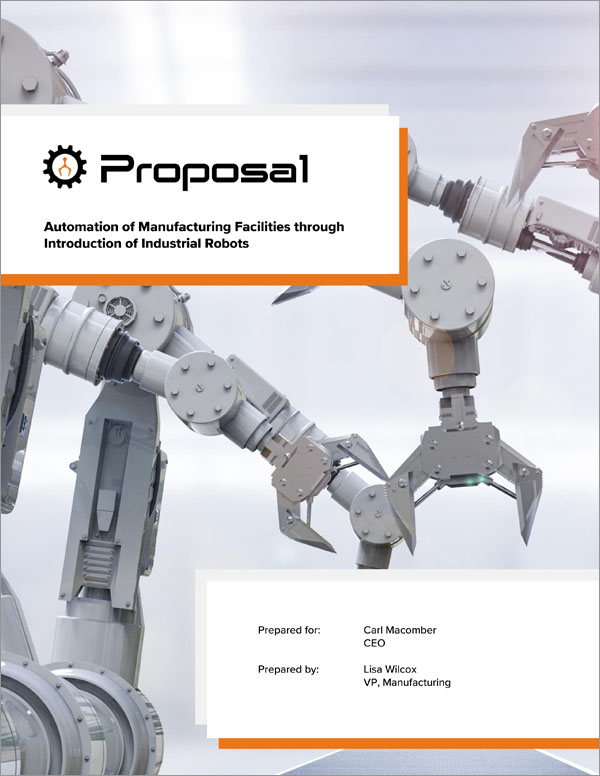
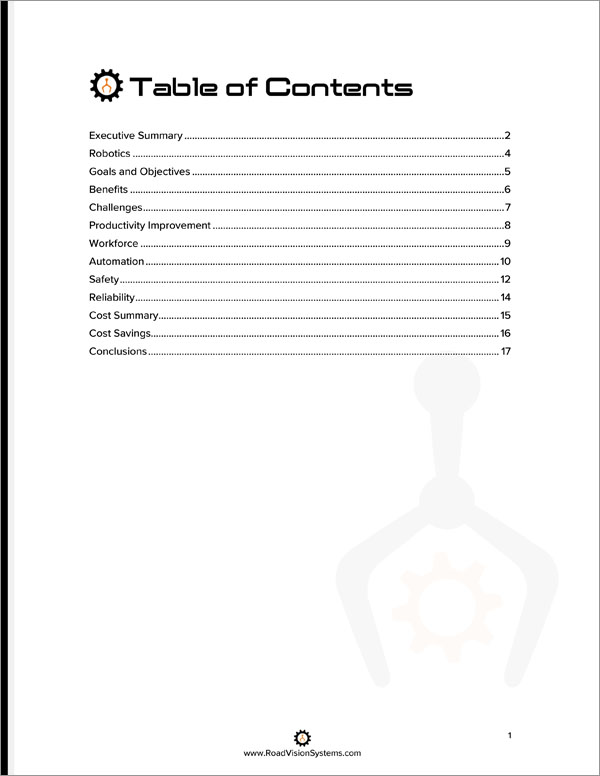
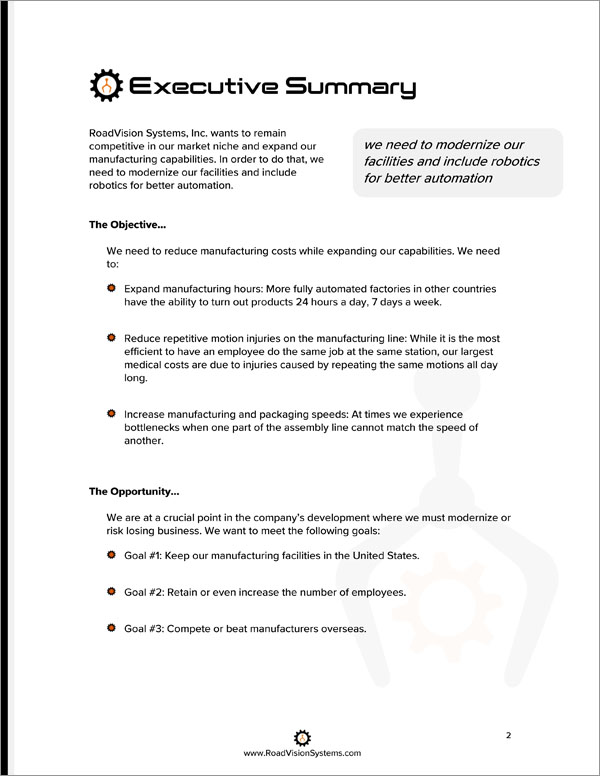
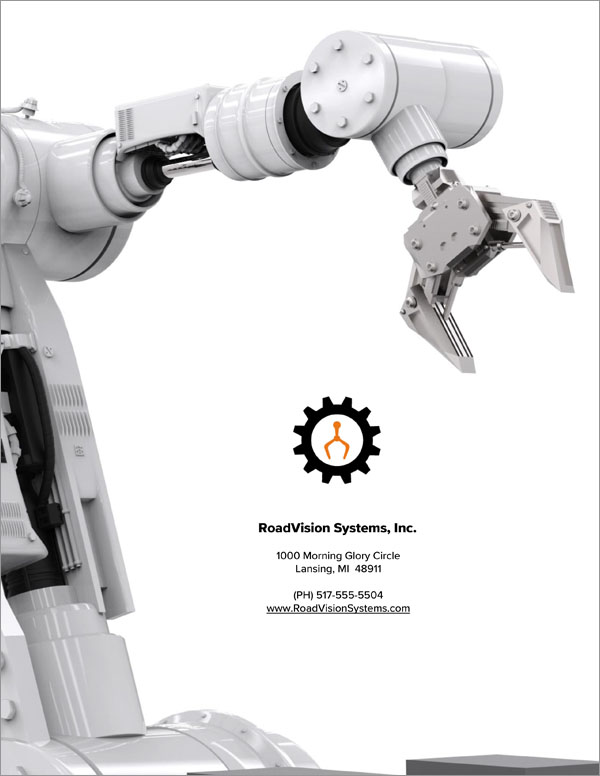
1. Get a Proposal Pack such as Robotics #2
This sample was created using the design theme Proposal Pack Robotics #2. You can recreate this same sample using any of our Proposal Pack design themes and have it customized for your business.
We include this Robotics Automation Project Sample Proposal in PDF and editable Word format chapters that can be customized using the included Wizard software.
To create your customized proposal using your logo and colors, get Proposal Pack for Any Business. We include this sample in every Proposal Pack.
2. Download and install after ordering
Once you have ordered and downloaded your Proposal Pack you will have all the content you need to get started.
3. Set up the included Wizard software
While the Wizard software makes the process more efficient, you can manually assemble your version of this sample using the content provided and just a Word processor.
4. Import the Quick Start layout titled 'Robotics Automation Project Sample Proposal'
The included Proposal Pack Wizard software makes creating a customized version of this document speedy and efficient. The sample content is in Word format documents, so you can also use the sample text without using our Wizard software.
This is a good example to follow for an internal company project proposal.
Anyone needing to write an internal company proposal or a manufacturing improvement project proposal.
5. Customize the template with your information
You can customize the layout with different chapters, change the order of chapters, import your content and information, change the visual design, edit the text, and more. You have complete control over customizing this sample.
Robotics Automation Project Sample Proposal - The Narrative
Discussion of Automation of Manufacturing Facilities through Introduction of Industrial Robots
As requested, I am submitting this proposal to automate our manufacturing facilities by introducing industrial robots. I have consulted in general with several robotic experts to develop the information I’ve enclosed here, and I believe the path is clear for us. If RoadVision Systems, Inc. wants to stay competitive and profitable, we must modernize ASAP.
Our competitors in Germany and China are introducing more automated processes to increase their production capacity, and if we don’t act soon, we will lose the majority of our market share for automotive mirrors and backup cameras, and be left only with orders for specialty items. For the sake of our workers and our shareholders, we cannot let that happen. To proceed, we need to include more staff members in the discussion, and we need to bring in robotics consultants to study our manufacturing processes and recommend specific machines for us to purchase.
Then, with that action plan in place, we need to schedule time for installation and training, and hire or retrain the employees we need to run and maintain the machines. This will be a major change for our company, but we cannot afford to stay the course we are on right now. Please review the information I’ve included in the following pages and let’s schedule a meeting to discuss this soon. RoadVision Systems, Inc. wants to remain competitive in our market niche and expand our manufacturing capabilities.
In order to do that, we need to modernize our facilities and include robotics for better automation.
We need to modernize our facilities and include robotics for better automation
The Objective
We need to reduce manufacturing costs while expanding our capabilities. Expand manufacturing hours. More fully automated factories in other countries have the ability to turn out products 24 hours a day, 7 days a week.
Reduce repetitive motion injuries on the manufacturing line. While it is the most efficient to have an employee do the same job at the same station, our largest medical costs are due to injuries caused by repeating the same motions all day long. Increase manufacturing and packaging speeds. At times we experience bottlenecks when one part of the assembly line cannot match the speed of another.
The Opportunity
We are at a crucial point in the company’s development where we must modernize or risk losing business. We want to meet the following goals. Keep our manufacturing facilities in the United States. Retain or even increase the number of employees.
Compete or beat manufacturers overseas.
The Solution
The only way to modernize our processes is to introduce more industrial robots. Robotics are already used in our mirror cutting systems. It’s time to use them in other areas. Use robots instead of assembly line workers to assemble our most commonly produced mirrors.
Use robots for quality control where possible. Use robots to package all products coming off the assembly line. Introducing more robots into our manufacturing processes is the key to success.
The idea of robots taking over has long been a nightmare of American workers. But the fact is that industrial robots have taken over many manufacturing jobs, and no human workers can match their speed and efficiency at performing repetitive tasks. Consider the following points.
Automation will make our company more competitive on a global basis Companies overseas are quickly automating their processes with robotics. We have to keep up. Robots can work 24 hours a day, 7 days a week. We can produce more products. Robots produce greater volumes of products faster. We can compete for larger orders.
Robots can reduce our expenses Robots don’t need lights or climate control, and they don’t get injured by repeating the same motions thousands of times per day. We’ll reduce both utility bills and medical expenses. Robots will replace some assembly line workers, but we can retrain some to program and supervise the robots, and we can increase our sales and design staff to take advantage of new capabilities.
By automating the manufacturing processes of RoadVision Systems, Inc., we strive to achieve all the following goals. We have always taken pride in being owned and grown in the USA, and we want to keep it that way. Increase productivity We must be able to produce larger orders faster to compete with overseas competitors. Reduce costs Employee benefits are our largest expenses right now.
Robots don’t take holidays, vacation, or sick days, and don’t become injured or disabled. Quickly achieve return on investment ROI The ability to produce our products more efficiently while reducing operating costs should offset the cost of installing robots within two years and increase profits for the foreseeable future. Keep our company and our jobs in the United States We have always taken pride in being owned and grown in the USA, and we want to keep it that way. Automating through robotics is not just one option, it’s our only option.
RoadVision Systems, Inc. will receive many benefits from automating the majority of our manufacturing processes. These benefits include. With increased automation, we should be able to run 24 hours a day, 7 days a week.
The ability to compete more effectively in a global market Many overseas competitors, especially those in China and Germany, are using industrial robots to produce products quickly and inexpensively. We must keep up with the industry to land contracts. Reduction of labor costs While we hope to retrain some manufacturing staff to work with the robots and plan to hire more expensive staff such as designers and programmers, overall we can expect to reduce costs of benefits such as vacation, sick leave, and health insurance which we now pay to our workers at times they are not producing.
Robots don’t get benefits and don’t expect raises and bonuses. The ability to bid on larger contracts Currently, we can bid only on contracts we know that our limited facilities and personnel can produce within the designated time frame. With increased automation, we should be able to run 24 hours a day, 7 days a week when needed, producing far more products than we can now.
Establish our reputation as a state-of-the-art facility Automated facilities are cleaner and more energy efficient, and thereby "greener" than employing a large workforce that commutes every day. We will be able to advertise our company as modern, efficient, and innovative, which should attract new customers. As you can see, the benefits we would receive from automation match the goals we have for our company. We recognize that we will face certain challenges during the course of automating our manufacturing facilities.
Some of these challenges are. Precisely identifying which jobs robots can do and what those robots will cost We will work with consultants on this process, but management will need to factor time into their schedules to make this happen. Cost of purchasing and installing robots As robots should pay for themselves within two or three years, this issue can be resolved with a short-term business loan. Downtime while robots are installed and staff adjusts to working with them We must figure sufficient time into our schedule to make this happen with no impact to our customers.
Pushback from employees Some employees on our manufacturing line will be laid off. We must determine how much headcount we will need after robots are installed, detail exactly which new jobs will be created, and determine if we can retrain some manufacturing staff or need to hire new staff. HR and managers will need to work closely together to handle all these staff issues in a humane, diplomatic fashion.
Automating our manufacturing processes will be a major change for RoadVision Systems, Inc., but if we want to remain in business in the future, we must embrace the possibilities and meet this challenge. Overall, productivity in the United States has increased over the past decade, and our factory is no exception. We’re proud of all the innovations we have introduced, but we can increase productivity even more through automation.
Analysis of Current Productivity
We have increased our productivity by 5-10% each of the last three years through more efficient scheduling and packaging, and by replacing glass-cutting workers with computerized laser machines to cut glass for our automotive mirror products. Our slowest manufacturing areas are assembly of rearview and side mirrors, and packaging products for shipping. We have polled our manufacturing supervisors and workers, and nobody has any good ideas about how we can increase productivity using our existing facilities and personnel. We are now producing at 100% of current capability.
Recommendations
Only one idea worth considering emerged from our poll on how to increase productivity. To decrease the variety of items we manufacture and thus devote more time to increasing the volume of those limited items we produce. However, it’s always risky to depend on very few clients; if the companies we were contracting with suddenly moved their manufacturing elsewhere or went out of business, we’d have no remaining developed client base to draw from.
However, by introducing more automation with industrial robots, we can produce a greater volume of each product in the same time frame, using our current facilities. We could then maintain the variety of contracts we accept or even increase the numbers of products we manufacture, while increasing the output of each product at the same time. Robots can be programmed to assemble our rearview and side mirrors as well as our back-up cameras, and robots can also efficiently package our products and stack them on pallets.
Robots can also do initial quality control scans and direct suspected problems to a human employee for solutions. More automation is the key to improved productivity for our company. Currently the majority of our workforce is made up of manufacturing line workers.
With more automation, many of those jobs would change or be eliminated, but other jobs would be needed. Our workforce is currently about 60% manufacturing assembly workers, 15% design engineering, 5% clerical, 10% sales, and 10% management. With automation, we predict the shift would be to approximately 40% manufacturing assembly; 25% design engineering, 5% clerical, 20% sales, and 10% management. Fewer workers would be needed on the factory floor, and to take advantage of increased capacity, we would need to add more designers and engineers and sales staff.
The new jobs on the manufacturing floors will be machine operators and support engineers. Machine operators will use computer consoles to set up and run the machines and monitor their work. Support engineers will maintain machines, testing and calibrating them, lubricating and repairing as needed.
HR can recommend which of our current factory employees are well suited for training into those new positions. We can never fully automate; some tasks will always need to be done by human workers, so not all factory workers will lose their current positions. New jobs in design and engineering will be applications engineers and software developers. With each new product we manufacture, we will need engineers to detail precisely all the movements the machines must make to produce that item, and software developers to code those routines into the machines.
The new jobs in sales would include the same responsibilities as the sales staff does now; we would simply need more sales staff to contact potential customers and make more deals to take advantage of our new capabilities. We should automate the assembly processes for our rearview and side mirror products, and possibly for our backup cameras as well. A robotics consultant can help us determine that. In addition, initial quality control scans, packaging, and palletizing can be done by machines.
Here’s a quick summary about how it would work. Automate assembly of rearview and side mirror products Non-Automated Process – Currently, all parts of each rearview mirror and side mirror are assembled by hand as they pass down the assembly line. Each rearview mirror passes through at least two stations, and our specialized rearview mirrors that can switch to backup view require a third station to attach wires, as do all of our side mirror products. We typically experience some glass breakage during the process when employees drop pieces or apply too much pressure during assembly.
Automated Process – Assembly robots can assemble each mirror in a fraction of the time it takes a worker to do it, and assuming precise programming , there will be no glass breakage. Automate quality control Non-Automated Process – Currently, a quality control technician observes parts as they move toward the packaging station and pulls out parts if they appear defective or flawed. This can be time-consuming, and the technician may miss some problems while concentrating on others. Automated Process – The assembly robots can precisely position each part on a conveyor belt so that a programmable "reader" can examine each part and then shunt aside for human examination any parts that don’t match programmed patterns.
This automated process is much faster and more accurate than our current process. Automate packaging and palletizing Non-Automated Process –Currently all our packaging is done by hand. This is strenuous, repetitive work, especially because we often produce thousands of the same part in each manufacturing run. Shifting packages to pallets for shifting is currently done by hand or with forklifts, which can be slow and arduous work that often results in worker injuries.
Automated Process - Packaging and labeling of parts can be done quickly and efficiently by machines. Machines can be programmed to assemble cardboard boxes around parts or to shift parts into pre-assembled boxes. Lifting and lowering of parts and packages can be done at precisely controlled speeds, thereby preventing damage to inventory or workers.
An industrial robotics expert will help us determine the precise jobs that machines can do in our factory, and teach us which jobs our workers must still do to interface with the machines. Safety is of the utmost importance to RoadVision Systems, Inc. Under our current manufacturing processes, our workers have experienced injuries from cutting and installing mirror glass, from lifting and lowering heavy packages, and from repetitive motions. Working with robots does not guarantee a safe environment for our employees, but according to OSHA records, robot-related injuries and deaths represent only a tiny fraction of workplace injuries and deaths recorded around the world.
There are two main areas of safety concerns when working with robots. Keeping human workers out of the robot work area Risks. Robots are strong and constantly moving according to their programming. Generally speaking, they are not programmed to make exceptions for intrusions into their workspace, so employees in the area may be struck and severely injured by robot movements if they wander into the robot’s work area.
We will need to develop strict policies on where our employees can be within our factory, and construct safeguards such as walls or floor markings to indicate "No Entry" zones. Managing power on off situations during robot inspections or repairs Risks. The majority of injuries and deaths have happened when robots are powered up by one employee who does not realize another employee is in the robot danger zone.
Additionally, severe accidents and even deaths have happened when a repair technician in the danger zone was electrocuted or accidentally activated a robot and nobody was available to turn off power and rescue that person. We will need to develop strict "lock out tag out" procedures for inspecting and repairing robots so that power cannot be accidentally turned on. We also need to schedule time and develop procedures to ensure that while a technician is servicing or repairing a robot, another employee is monitoring the situation and is able to immediately turn off power and if necessary call for help. Generally speaking, working with robotic equipment is much less accident-prone than our current manufacturing processes, but an accident involving a powerful robot can be more severe or even fatal, so we must adopt and enforce new safety practices as soon as new equipment is introduced.
OSHA can assist us in doing risk assessment and developing lock out tag out procedures. RoadVision Systems, Inc. values its employees, who are generally reliable. But when a worker is late or sick or doesn’t show up at all, that can disrupt the entire manufacturing process.
Robots, on the other hand, are always at their stations and prepared to do their work. They can work 7 days a week, 24 hours a day. But robots, like all machines, can break down.
They must be properly programmed and maintained, lubricated, and cleaned. Strategic parts will wear out and need to be replaced. When a robot ceases to function on our manufacturing line, it will shut down our entire production. We cannot simply call in another robot to take the nonfunctioning robot’s place.
To avoid shut-downs, we must be vigilant about maintaining robotic equipment and keeping spare parts on hand. We must train operators and support technicians to properly and safely monitor and service robots to keep them good working order, and we must build robot-servicing time into our manufacturing schedules so that we never feel compelled to run machines in situations they were not designed for. The numbers shown above are estimates only. Actual prices of robots will be determined by consulting with experts, and costs of maintenance and replacement parts will depend on our level of usage of robots in our factory.
Although the purchase of robotic equipment and hiring retraining of employees to manage and maintain them may look daunting, over time robots will save our company a lot of money. We will reduce our overall staff Sadly, some of our manufacturing staff will need to be laid off. The new positions we will need may be higher in salary, but they are fewer in number, and overall we will save in providing benefits for fewer employees.
We will have less downtime due to sickness and injury Robots don’t get sick, and if properly maintained, will stay on the job 24 7. Productivity will be higher with automation Each automated task will take much less time, so we can manufacture products in greater volume, thus reducing our cost to manufacture each item. The ROI for automation is predicted to be two years. After that, each year we reap the benefits of automation.
Change is always painful, but in industry, it’s inevitable if we want to stay in business. Here’s a brief summary of our conclusions. Our competitors are automating at a rapid rate; we must do so, too.
We want to keep our company and our jobs in the United States We may have fewer jobs after automation, but with increased capacity, our profits will grow and perhaps our workforce will, too. We need to compete with other manufacturers around the globe Our competitors are automating at a rapid rate; we must do so, too. We want to increase manufacturing speed and capabilities Industrial robots will allow us to produce more products faster.
We want to reduce injuries among our employees By using robots to perform repetitive tasks and to lift and lower heavy parts, our employees will have less down time due to injury. We want to be known as a state-of-the-art manufacturer Modernizing our manufacturing facilities will improve our reputation in the industry. Increased automation through introduction of industrial robots is the key to our company’s future RoadVision Systems, Inc. must modernize to embrace the future of our industry.
 What Our Clients Say
What Our Clients SayThank you for your quick response. I also want to note that this software Proposal Kit is great!"
Pure Country Air, Inc.
Length of Sample
17 PagesThere are thousands of chapters to choose from in Proposal Pack. This sample uses the following set of Proposal Pack chapter templates: Cover Letter, Title Page, Table of Contents, Executive Summary, Cost Summary, Challenges, Goals and Objectives, Benefits, Automation, Productivity Improvement, Safety, Robotics, Cost Savings, Conclusions, Reliability, Workforce, Back Page.
There are 200 complete sample proposals including this one in each Proposal Pack
The following related samples are also included in Proposal Pack:
- IT Product and Service Sales Proposal
- Technology Consulting Sample Proposal
- Software Automation Sample Proposal
- Process Improvement Sample Proposal
- Software and Hardware System Sample Proposal
- Manufacturing Process Improvement Sample Proposal
- Manufacturing and Distribution Sample Proposal
- 3D Printing Prototyping Services Sample Proposal
This sample illustrates how to write the following types of proposals
- General business proposal
- Technical proposal
- Project pitch proposal
- Internal company proposal
- IT, software, hardware proposal
- Manufacturing, engineering, fabrication proposal
- Many other types of proposals
Samples can be created in any Proposal Pack design theme
This sample was created with Proposal Pack Robotics #2. To change the visual look purchase any Proposal Pack and this sample will be created in that design theme.
Out of the over 501 Proposal Packs available these designs are also popular for this type of proposal and this sample proposal is also included in every Proposal Pack:
Photo Design Proposal Packs
 Proposal Pack Computers #5
Proposal Pack Computers #5 Proposal Pack Contemporary #19
Proposal Pack Contemporary #19 Proposal Pack Robotics #1
Proposal Pack Robotics #1 Proposal Pack Software #1
Proposal Pack Software #1 Proposal Pack Tech #8
Proposal Pack Tech #8Line Art Design Proposal Packs
 Proposal Pack Concepts #1
Proposal Pack Concepts #1 Proposal Pack Concepts #11
Proposal Pack Concepts #11 Proposal Pack Concepts #5
Proposal Pack Concepts #5 Proposal Pack Tech #1
Proposal Pack Tech #1 Proposal Pack Tech #3
Proposal Pack Tech #3 Proposal Pack Tech #5
Proposal Pack Tech #5
 4.7 stars, based on 842 reviews
4.7 stars, based on 842 reviews Ian Lauder has been helping businesses write their proposals and contracts for two decades. Ian is the owner and founder of Proposal Kit, one of the original sources of business proposal and contract software products started in 1997.
Ian Lauder has been helping businesses write their proposals and contracts for two decades. Ian is the owner and founder of Proposal Kit, one of the original sources of business proposal and contract software products started in 1997.By Ian Lauder
 Published by Proposal Kit, Inc.
Published by Proposal Kit, Inc.


 Cart
Cart
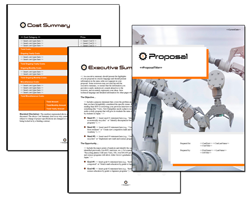
 Facebook
Facebook YouTube
YouTube X
X Search Site
Search Site